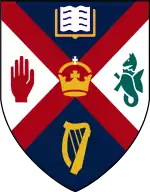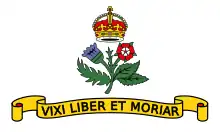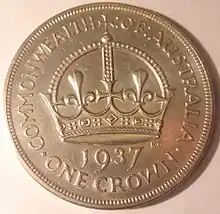.svg.png.webp)
The Tudor Crown, also known as the Imperial Crown, is a widely used symbol in the heraldry of the United Kingdom. In use officially from 1902 to 1953 and again from 2022, it represents both the British monarch personally and "the Crown", meaning the sovereign source of governmental authority. As such, it appears on numerous official emblems in the United Kingdom, British Empire and Commonwealth.[1]
History

The heraldic depictions of the royal crown have undergone many changes in their form and enrichment. The crown began to assume its present form in the reign of Henry V. Henry V's crown consisted of a jewelled circlet heightened by four crosses pattée alternating with eight fleurs-de-lis in pairs, and two arches springing from behind the crosses and supporting at the top a mound and cross (similar to an orb). In some reigns additional arches were used, and the number of crosses pattée and fleurs-de-lis was varied. By the reign of Charles I the royal crown was depicted similarly to the Tudor crown (made either for Henry VII or Henry VIII) which had four crosses pattée alternating with four fleurs-de-lis, and also four arches rising almost to a point, the arches being studded with pearls. This crown was destroyed during the Protectorate.[2]
After the restoration of the monarchy, Charles II based the royal crown on the new St Edward's Crown, which had four crosses pattée alternating with four fleurs-de-lis, the number of arches was reduced to two and the curvature of the arches being depressed at the point of intersection. On this pattern the royal crown was depicted until the reign of Queen Victoria.[2]

While various crown symbols had been used for this purpose for many years previously, in 1880 after Queen Victoria became Empress of India it was felt that the heraldic crown should be given an imperial form, and this was effected by making the arches semi-circular joined at the top with the mound and cross. The new design was never intended to represent any actual physical crown and its depiction was never officially standardised at the time, although in shape it bears a close resemblance to both the Imperial State Crown and the small diamond crown of Queen Victoria.[2][3] As a result of this change the depiction of the crown was very much "at the mercy" of the artist and many variants emerged. After the accession of Edward VII the War Office raised the issue of a standardised design for use by the army. The king decided on the 'Tudor' or 'imperial' crown design, and henceforth only this depiction of the crown was used.[4]
In 1952 Queen Elizabeth II requested the design be replaced with a representation of the St Edward's Crown which she wore at her coronation. Many, though not all, of the derived designs around the world were updated to match.[2]
In Canada, the Tudor Crown has been used since 1907 in the Canadian Government Inspection Legend on inspected meat products. The inspection legend (or symbol) consists of two concentric circles: the outer ring has the word "Canada" at the top and a number at the bottom identifying the place of production; the inner circle contains a black and white rendering of the Tudor Crown.
Following the death of Elizabeth II, the design of King Charles III's royal cypher was announced on 27 September 2022, which featured the Tudor crown rather than the St Edward’s Crown. According to the College of Arms, this depiction will now be used in representations of the Royal Arms, badges and military uniforms.[5]
Gallery
Coats of arms
.svg.png.webp) Royal coat of arms of the United Kingdom (2022–present)
Royal coat of arms of the United Kingdom (2022–present)_(2022).svg.png.webp) Royal coat of arms of the United Kingdom as used by HM Government (2022–present)
Royal coat of arms of the United Kingdom as used by HM Government (2022–present).svg.png.webp) Royal coat of arms of the United Kingdom (1901–1952)
Royal coat of arms of the United Kingdom (1901–1952).svg.png.webp) Royal coat of arms of the United Kingdom as used by HM Government (1901–1952)
Royal coat of arms of the United Kingdom as used by HM Government (1901–1952) Coat of arms of Queen Alexandra, consort of Edward VII
Coat of arms of Queen Alexandra, consort of Edward VII Coat of arms of Queen Mary, consort of George V
Coat of arms of Queen Mary, consort of George V Coat of arms of Queen Elizabeth, consort of George VI
Coat of arms of Queen Elizabeth, consort of George VI Coat of arms of Queen Camilla, consort of Charles III
Coat of arms of Queen Camilla, consort of Charles III.svg.png.webp) Seal of Annapolis
Seal of Annapolis Coat of arms of Australia (1912–1953)
Coat of arms of Australia (1912–1953) Coat of arms of Queen's University Belfast
Coat of arms of Queen's University Belfast.svg.png.webp) Royal arms of Canada (1921–1957)
Royal arms of Canada (1921–1957) Crest of Royal College Colombo (pre–1954)
Crest of Royal College Colombo (pre–1954) Coat of arms of the University of Dublin
Coat of arms of the University of Dublin Badge of Royal Netherlands Air Force 322 Squadron
Badge of Royal Netherlands Air Force 322 Squadron Coat of arms of Northern Ireland (1924–1972)
Coat of arms of Northern Ireland (1924–1972) Coat of arms of the Orange River Colony (1904–1910) and the Orange Free State (1910–1925)
Coat of arms of the Orange River Colony (1904–1910) and the Orange Free State (1910–1925)
.svg.png.webp) Coat of arms of Queensland (1902–1953)
Coat of arms of Queensland (1902–1953) Coat of arms of Singapore (1948–1959)
Coat of arms of Singapore (1948–1959).svg.png.webp) Coat of arms of British Somaliland (1950–1953)
Coat of arms of British Somaliland (1950–1953) Coat of arms of the Straits Settlements (1901–1946)
Coat of arms of the Straits Settlements (1901–1946) Coat of arms of Victoria (1910–1953)
Coat of arms of Victoria (1910–1953).svg.png.webp)
Cyphers

 Royal cypher of King George V
Royal cypher of King George V Royal cypher of King Edward VIII
Royal cypher of King Edward VIII Royal cypher of King George VI
Royal cypher of King George VI Royal cypher of King Charles III
Royal cypher of King Charles III Dual cypher of Charles III and Queen Camilla
Dual cypher of Charles III and Queen Camilla Design element of Queen Elizabeth the Queen Mother's 90th birthday commemorative coin, 1990
Design element of Queen Elizabeth the Queen Mother's 90th birthday commemorative coin, 1990
Flags
 Flag of Annapolis
Flag of Annapolis
.svg.png.webp) Flag of the governor-general of Australia (1902–1908)
Flag of the governor-general of Australia (1902–1908).svg.png.webp) Flag of the governor-general of Australia (1908–1936)
Flag of the governor-general of Australia (1908–1936).svg.png.webp) Flag of the governor-general of Australia (1936–1953)
Flag of the governor-general of Australia (1936–1953).svg.png.webp) Flag of The Bahamas (1904–1923)
Flag of The Bahamas (1904–1923).svg.png.webp) Flag of The Bahamas (1923–1953)
Flag of The Bahamas (1923–1953).svg.png.webp) Flag of the governor of The Bahamas (1904–1953)
Flag of the governor of The Bahamas (1904–1953).svg.png.webp)
.svg.png.webp)
.svg.png.webp) Flag of the governor general of Canada (1901–1921)
Flag of the governor general of Canada (1901–1921).svg.png.webp) Flag of the governor general of Canada (1921–1931)
Flag of the governor general of Canada (1921–1931).svg.png.webp) Flag of the governor general of Canada (1931–1953)
Flag of the governor general of Canada (1931–1953).svg.png.webp) Flag of the governor-general of Ceylon (1948–1953)
Flag of the governor-general of Ceylon (1948–1953).svg.png.webp) Flag of the Colony of Fiji (1903–1908)
Flag of the Colony of Fiji (1903–1908).svg.png.webp) Flag of the governor of Fiji (1903–1908)
Flag of the governor of Fiji (1903–1908)
.svg.png.webp) Flag of the governor-general of India (1901–1947)
Flag of the governor-general of India (1901–1947).svg.png.webp) Flag of the governor-general of India (1947–1950)
Flag of the governor-general of India (1947–1950) Flag of the British Indian Army (1942–1947)
Flag of the British Indian Army (1942–1947) Flag of Llandovery
Flag of Llandovery.svg.png.webp) Flag of the Colony of Natal (1901–1910)
Flag of the Colony of Natal (1901–1910).svg.png.webp) Flag of the British New Hebrides (1906–1953)
Flag of the British New Hebrides (1906–1953).svg.png.webp) Flag of the Resident Commissioner of the British New Hebrides (1906–1953)
Flag of the Resident Commissioner of the British New Hebrides (1906–1953).svg.png.webp) Flag of the governor-general of New Zealand (1936–1953)
Flag of the governor-general of New Zealand (1936–1953).svg.png.webp) Flag of Colonial Nigeria (1914–1953)
Flag of Colonial Nigeria (1914–1953).svg.png.webp) Flag of the governor of Nigeria (1914–1953)
Flag of the governor of Nigeria (1914–1953).svg.png.webp) Flag of Northern Ireland (1924–1953)
Flag of Northern Ireland (1924–1953).svg.png.webp) Flag of the governor of Northern Ireland (1924–1973)
Flag of the governor of Northern Ireland (1924–1973).svg.png.webp) Flag of the governor-general of Pakistan (1947–1953)
Flag of the governor-general of Pakistan (1947–1953) Flag of the lieutenant governor of Quebec
Flag of the lieutenant governor of Quebec.svg.png.webp) Flag of Queensland (1901–1953)
Flag of Queensland (1901–1953).svg.png.webp) Flag of the governor of Queensland (1901–1953)
Flag of the governor of Queensland (1901–1953).svg.png.webp) Flag of the Crown Colony of Singapore (1946–1953)
Flag of the Crown Colony of Singapore (1946–1953).svg.png.webp) Flag of the governor of Singapore (1946–1953)
Flag of the governor of Singapore (1946–1953).svg.png.webp) Flag of the British Solomon Islands (1906–1947)
Flag of the British Solomon Islands (1906–1947).svg.png.webp) Flag of British Somaliland (1950–1953)
Flag of British Somaliland (1950–1953).svg.png.webp) Flag of the governor of British Somaliland (1950–1953)
Flag of the governor of British Somaliland (1950–1953).svg.png.webp) Flag of the governor-general of South Africa (1931–1953)
Flag of the governor-general of South Africa (1931–1953).svg.png.webp) Flag of the governor of Southern Rhodesia (1951–1953)
Flag of the governor of Southern Rhodesia (1951–1953).svg.png.webp) Household flag of the governor of Southern Rhodesia (1940–1952)
Household flag of the governor of Southern Rhodesia (1940–1952).svg.png.webp) Flag of the Straits Settlements (1904–1925)
Flag of the Straits Settlements (1904–1925).svg.png.webp) Flag of the Straits Settlements (1925–1946)
Flag of the Straits Settlements (1925–1946).svg.png.webp) Flag of the governor of the Straits Settlements (1904–1946)
Flag of the governor of the Straits Settlements (1904–1946).svg.png.webp) Flag of Victoria (1901–1953)
Flag of Victoria (1901–1953).svg.png.webp) Flag of the governor of Victoria (1901–1953)
Flag of the governor of Victoria (1901–1953).svg.png.webp) Flag of the British Windward Islands (1903–1953)
Flag of the British Windward Islands (1903–1953).svg.png.webp) Flag of the Governor-in-Chief of the British Windward Islands (1903–1953)
Flag of the Governor-in-Chief of the British Windward Islands (1903–1953).svg.png.webp) King's Colour for the Royal Navy (1925–1936)
King's Colour for the Royal Navy (1925–1936).svg.png.webp) King's Colour for the Royal Navy (1936–1952)
King's Colour for the Royal Navy (1936–1952) King's Colour for the Royal Navy (2023–present)
King's Colour for the Royal Navy (2023–present) Ensign of the Royal Irish Yacht Club
Ensign of the Royal Irish Yacht Club Ensign of the Royal St. George Yacht Club
Ensign of the Royal St. George Yacht Club.svg.png.webp) Ensign of the Royal Jamaica Yacht Club (pre–1953)
Ensign of the Royal Jamaica Yacht Club (pre–1953) Flag of the Vanguard Unionist Progressive Party (1972–1978)
Flag of the Vanguard Unionist Progressive Party (1972–1978)
Others
 "Keep Calm and Carry On" wartime poster
"Keep Calm and Carry On" wartime poster

.jpg.webp) Scottish police cap badge (worn until 1975)
Scottish police cap badge (worn until 1975) Reverse of a 1953 half crown
Reverse of a 1953 half crown Crown (Australian coin) 1937, 1938
Crown (Australian coin) 1937, 1938
See also
References
- ↑ Boutell, Charles (1864). Heraldry, Historical and Popular. Richard Bentley. p. 318. Retrieved 24 March 2015.
- 1 2 3 4 Boutell, Charles (1973). Boutell's heraldry ([Rev. ed.] ed.). London: F. Warne. pp. 183–185. ISBN 0-7232-1708-4. OCLC 834888.
- ↑ Canada, Senate of. "The Rose and Crown: Parliament's royal symbols, part one". SenCanada. Retrieved 2023-11-16.
- ↑ Fox-Davies, Arthur Charles; Niehoff, D. L.; Kuhar, M. J. (2015). A complete guide to heraldry. Vol. 179 (1st ed.). La Coruña: Orbigo. pp. 359–360. doi:10.1016/0006-8993(79)90456-6. ISBN 978-84-9994-891-1. ISSN 0006-8993. OCLC 922086108. PMID 41617.
- ↑ "Royal Cypher - College of Arms". www.college-of-arms.gov.uk. Retrieved 2022-09-28.
.svg.png.webp)